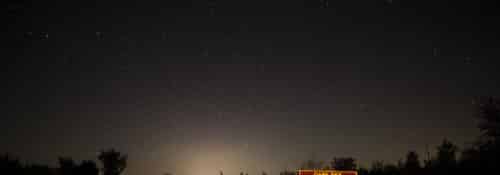
Pursuing the Beautiful: Nighttime at Dark Sky Park
by Nina Hufford
“Let’s go tonight! This is our last chance to see a Super Blood Wolf Moon Eclipse!”
“Where would we go?”
“Dark Sky Park. It’s only half an hour away, so we’ll be back before your bedtime.”
I was in the process of impatiently wrangling friends into coming with me on a school night to Dark Sky Park to watch a lunar eclipse. To my surprise, quite a few people wanted to come once they heard me rave about the park’s view of the sky as well as its proximity to campus. After assembling a group of ten people, two cars, and countless blankets, hats, and scarves to fend off the subzero temperatures, we caravanned our way out of town.
When a little sign notified us that we had arrived at Lake Hudson Recreation Area (the technical name for Dark Sky Park), we bumped along the park’s dirt road until we picked a satisfactory turn-off, and then piled out of the car.
Each time someone stepped into the cold, there was a gasp, but most of the shock came from the sudden view of the overwhelmingly starry sky. It’s easy to forget what the unpolluted night sky looks like when lights from suburban streets combine to shroud the observer in an electronic day. While we waited for the moon to disappear, we watched shooting stars dart across the sky. As the moon darkened and slowly turned red, more and more of these meteors became visible.
On a more recent trip, we went with the purpose of seeing the Northern Lights. We took a side road that led to a lake which mirrors the starry sky so well that the horizon line becomes hard to detect. Unfortunately, the Northern Lights didn’t appear, but we were able to see some winter constellations, including Orion, Perseus, and Gemini, as well as a ring around the moon called a 22 degree halo, or “moonbow” by the less scientific. Visits to this park teach that there is always something transpiring in the night sky.
Since seeking out the good is not an endeavor limited to the classroom, it can mean sunset-chasing or star-tipping. Hillsdale’s proximity to a park where you can do both makes it easier for a student to see how the true and the beautiful are connected, and to experience their connection in a tangible way. I think Dark Sky Park’s beauty is especially important in the education of a person because it works to instill a sense of wonder, which is necessary for any kind of learning. A view of the vast and open starry sky never fails to make me feel my littleness and limited perspective. That might be why I can’t get enough of this place.
Nina Hufford, ’20, grew up in Ann Arbor, MI, where she inherited her outdoor spirit and elephant pants. She studies English and Spanish at Hillsdale, as well as the trees, poems, and people she encounters daily. In her free time, she enjoys canoeing, playing soccer, and swinging on the porch.
Published in July 2019